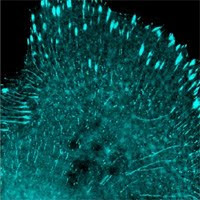The
ability to modify genomes has always been fervidly sought after by
molecular, developmental biologists and geneticists as it would provide
them with the means for finding out what a particular piece of the
genome may do in the biological process they are studying. The discovery
of naturally existing P-element helped a generation of Drosophila geneticists
and made the fruit fly a prime model system for gene function studies
in the 80’s and 90’s. But P-elements inserted at uncontrolled sites,
making it essentially a gene transfer vehicle without much control. The
introduction of prokaryotic recombination systems, e.g. LoxP and Cre,
provided researchers with tools to obtain more control of the inserted
genes in a host chromosome during a biological process such as
development. Transposons like Sleeping Beauty, Piggybac, or Tol2 made
similar experiments possible in mammalian cells.
Still,
the randomness of transposon-type elements’ insertion, much like
retrovirus or lentivirus, could cause trouble if they land in an
undesirable spot. Methods of inserting transgenes only in well-known,
harmless, and transcriptionally active regions, so called “safe
harbors”, were subjects of interest of researchers and NIH grant topics
in the past couple of years under “directed genome editing”. Gene
knock-out or knock-in can be achieved through vector-mediated homologous
recombination such as the rAAV genome engineering system and the
“TARGATT” system, which are commercially available as kits or services.
However,
instead of inserting an exogenous gene, it is often highly desirable to
modify an endogenous genome sequence, which requires the modification
apparatus to first recognize the target sequence. ZFN and TALEN both
recognize DNA targets through specific nucleotide binding protein
domains, with TALEN having more flexibility if assembled in a
“Lego”-like format because each domain can specifically recognize a “C”,
“G”, “T”, or “A” base. The description of using CRISPR/cas system in a
recent burst of publications opened up new ways of binding to specific
DNA sequences and nicking or severing the dsDNA. This system does not
require engineeredDNA binding domain assembly; instead, it uses a guide
RNA to find the target DNA sequence to direct endonuclease, in a sense
quite like RNAi. However, the enthusiasm about CRISPR/cas was somewhat
dampened by a report last month in Nature Biotechnology that reported
off-target effects of CRISPR/cas was much higher than ZFN and TALEN.
Particularly, if mismatches are located in the 5’ portion of the guide
RNA targeting sequence, they can be well tolerated up to 3 or 4, even 5
mismatches. Unfortunately this is also similar to the tolerance of the
RNAi matching region outside the core 12-base region. The difference is:
for RNAi, the off-target damage is temporary and ignorable if the
extent is insignificant compared to the effects on the intended target
while for CRISPR/cas, an off-target cut on the chromosome is permanent.
On the positive side, in an even more recent publication in Nature Methods, mutant strains of C. elegans
were obtained using the CRISPR/cas system and no evidence was found for
off-target changes, at least not in an overwhelming fashion. Much
value of the estimates of off-target effects relates to the methods used
for analysis. Currently, most of the studies looked at potential
off-target sides by searching for partial matches. In the future, whole
genome sequencing will be increasingly required for submitting such
publications.
On
a practical note, if you intend to take a dive and try to use any one
of these methods, your number one problem will be that none of the
methods will result in 100% modification even if you can ignore the
off-target problems for now. Therefore, many of our customers ask about
a screening strategy. One could use traditional drug selection and
fluorescent protein (FP)-based sorting, but these can only help you find
cells that are successfully transfected with the ZFN, TALEN, or
CRISPR/cas expressing DNA molecules, not necessarily having the genome
modification result. We have formulated the idea of inserting the
target site into an FP-bearing plasmid as a surrogate target cutting
indicator, and use another FP to track transfection of the TALEN plasmid.
Nonetheless, in the end, PCR-amplifying the target region of the
chromosome and doing either an enzymatic mismatch detection assay (e.g.
T7 endonuclease) or sequencing is the only way to know for sure whether
genome editing has occurred.




No comments:
Post a Comment